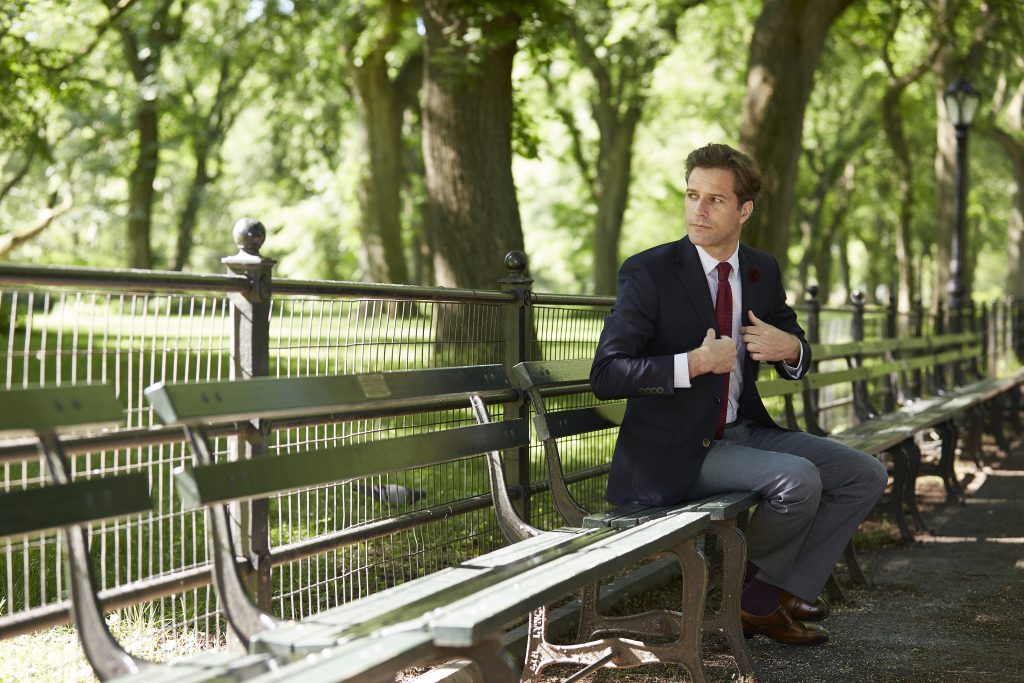
…and then helped rescue another American suit factory.
Hart Schaffner Marx has been making exquisite American-made men’s suits in Chicago since 1887.

There is a long history of peaks and valleys at the Chicago-area manufacturing plant where the suits are made, including partnership changes, brand acquisitions, financial troubles and a union workers’ strike.
But throughout its sometimes volatile 131-year history, there has been one constant at Hart Schaffner Marx: Its luxury suits have always been Made in America.
Former President Barack Obama often sported the Hart Schaffner Marx brand while in office, and even wore a tuxedo made by his hometown company to his inauguration in 2009.
Another American political leader, Ohio Sen. Sherrod Brown (D-Ohio), not only frequently wears Hart Schaffner Marx suits, but also likes to point out his suits are made just outside of Cleveland at an old Hugo Boss factory.
That facility nearly shut down for good a few years ago, but was rescued with the help of Brown, the plant’s workers, the Workers United labor union, and Doug Williams, the current owner and CEO of the Hart Schaffner Marx brand.
“Our union came to me, along with Senator Brown, and said Hugo Boss is pulling out of Cleveland and asked if we would like to take a look at the factory and see if there is something we could do to save it,” said Williams.
A Rescue — and Then Another
Taking over the Cleveland factory was an intriguing proposition for Williams, who is no stranger to the fashion business — or keeping an American factory afloat.
Williams worked for Ralph Lauren early in his career, and after 16 years with the company retired as Ralph Lauren Group President in 2004. He went on to acquire Seattle-based outdoor hunting and fishing brand Filson, partnering with Brentwood Associates. They eventually sold Filson to Tom Kartsotis, owner of the Detroit-based Shinola, now famous for its Made in America watches and other luxury items.
Around that time, a new opportunity arose.
While sales of Hart Schaffner Marx suits remained steady, its parent company Hartmarx Corporation was failing badly. It had acquired too many brands, draining its capital. Hartmarx went bankrupt in 2008, and Williams was brought in to manage the turnaround to a company in India that bought Hartmarx.
But the Indian company failed to put capital back into the company and it continued to struggle. Williams took it back into bankruptcy and arranged a deal that ultimately saved it.
Authentic Brands Group, known for developing brands like Aeropostale, Juicy Couture, and Nine West, purchased the Hart Schaffner Marx trademark during the bankruptcy. Williams licensed the Hart Schaffner Marx brand in 2012 from Authentic Brands and put together a 40-year licensing deal.
He then became the sole owner of Hart Schaffner Marx. “I bought all of the operating companies, cleaned them up and am proud to say that all these turnarounds I have done, not one American manufacturing job has been lost,” Williams said.
Williams plan was to return to the basics – a family business making classic, men’s suits in the Chicago area just as founders Harry and Max Hart did in 1887.
“In the end, I always say to people when you choose to buy Made in the U.S.A., it’s also a chance to support your community.” Doug Williams, Hart Schaffner Marx
But the Chicago-area factory located in nearby Des Plaines, Ill. was having trouble keeping up with demand.
“Our Chicago facility can make about 195,000 coats per year and roughly 70,000 pair of pants,” Williams said. “The demand from our customers was close to 240,000 coats and about 150,000 pair of pants so we were running the Chicago factory with close to ten hours a week of overtime, all of the time.
“I was trying to hire an additional 80 people in Chicago, but it is very, very difficult to find skilled workers to run sewing machines and pressing machines and do the quality work we need. Out of every three people I hired, only one would eventually make it and the training was costly.
“So when Sen. Brown and the union came to me and said there are a little over 100 people in the Cleveland area that are going to lose their jobs with Hugo Boss, candidly, what I looked at is the fact there are 100 people who know how to run sewing machines, know how to run pressing machines, and I need them. So, we acquired the factory from Hugo Boss and we’ve been operating it now for four years.”
As the old saying goes, “one man gathers what another man spills.”
Combined employment at the two factories is nearly 700 workers, which include cutters, sewers and press operators. Hart Schaffner Marx employees are represented by the Workers United union, the labor organization that played a pivotal role in saving the Ohio factory.
While Hart Schaffner Marx suits are manufactured in America by union workers, some of the fabric must be outsourced from other countries, Williams said.
“When it comes to fine woolens, there is only one mill left in the United States that can provide fabric for suits like ours and that’s a factory called American Woolens in Connecticut,” said Williams. “Most all of the woolens we import from other countries comes from sheep in New Zealand, because the fineness of the wool is very different from the coarseness of the wool of American sheep.”
The supply chain for a variety of fine fabrics is sadly no longer available in America. Hart Schaffner Marx uses close to 100 different fabrics in its suits. With three different basic models and the many variations on those models, the clothier produces between five- and six-hundred different suit styles each season.
“Since I bought the company back in 2012, our business is about 40 percent bigger than it was back in 2012,” Williams said. “I attribute it to we make beautiful garments. Customers like what we make, and they like how they fit. So, the first thing is the product.
“The second thing, very candidly, when Men’s Wearhouse bought Joseph Abboud, it was taken out of the wholesale distribution channel, so there was a void created and we picked up a huge part of that void.”
Hart Schaffner Marx suits are sold in high-end department stores such as Nordstrom, Bloomingdale’s, Dillard’s and smaller men’s specialty outlets, and are priced in the $700 to $1200 range.
Opportunities for a Special Workforce
Along with rescuing an iconic American company, purchasing Hart Schaffner Marx also offered Williams the opportunity to own and operate a family-run business that also supports the special needs community.

Williams is the sole family member to work at Hart Schaffner Marx, but it was his son, Hayden, who inspired the installation of a much-respected additional workforce.
Hayden has autism and was fortunate to have the special care needed during his childhood and teenage years. But when Hayden was nearing high school graduation, Williams began to wonder what would become of his son while transitioning into adulthood.
It is estimated that 50,000 autistic high school graduates no longer receive the support they did in childhood.
So, with the help of a company called Autism Workforce, Williams retooled everything at Hart Schaffner Marx in Des Plaines to fit how people with autism live and think. He created a bonus workforce, gave autistic young adults a chance to earn a living, maintain a level of independence and retain their dignity.
“You are part of a community and you can choose to be a positive part,” said Williams.
When Williams bought Hart Schaffner Marx out of bankruptcy, he divested everything under the Hartmarx brand except for the suit manufacturing business. The simplification of owning just two manufacturing plants may have been the savior of the heritage, all-American Hart Schaffner Marx brand.
“All of our marketing has Made in USA on it as well as the labels on the garments,” Williams said. “In the end, I always say to people when you choose to buy Made in the U.S.A., it’s also a chance to support your community.
“Every manufacturing job supports four different jobs in the community. If Americans would make a conscience choice to buy one product a year of made in America apparel – and I don’t care if it’s a sock a suit or a shirt – it would add close to 800,000 manufacturing jobs in the U.S.”
